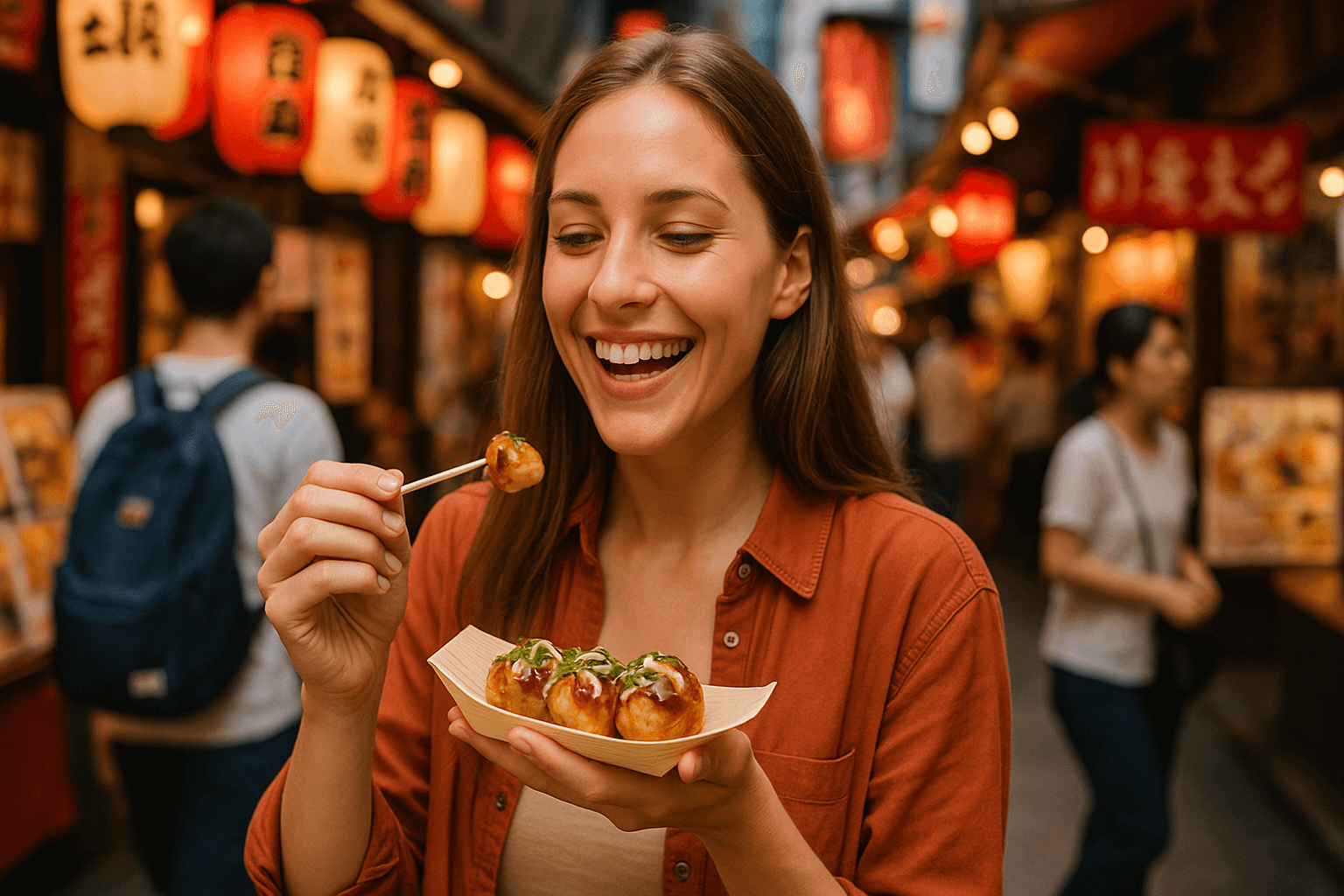Osaka is often called “the kitchen of Japan”, and for good reason. With its vibrant street food, bustling markets, hidden izakayas, and Michelin-starred restaurants, Osaka is a paradise for anyone who loves to eat. Locals even have a phrase for it—“kuidaore”, which means “to eat until you drop.”
But with so many choices, where should you start? This Osaka food guide takes you through the city’s famous street eats, lively markets, cozy bars, and even secret restaurants that only locals whisper about. Whether you’re traveling on a shoestring or splurging on a gourmet feast, Osaka has something for every appetite.
Osaka as the Kitchen of Japan
Unlike the refined elegance of Kyoto or the fast-paced glamour of Tokyo, Osaka’s food scene is hearty, casual, and fun. It’s the birthplace of some of Japan’s most beloved comfort foods—crispy takoyaki balls, sizzling okonomiyaki pancakes, and deep-fried kushikatsu skewers.
Walking through neighborhoods like Dotonbori or Shinsekai, you’ll see neon lights competing with sizzling grills and chefs shouting out orders. Eating here isn’t just about the food—it’s about the atmosphere. You’re meant to grab a snack, sip some sake, and share laughter with friends.
This guide is your passport to eating like a local, beyond the tourist brochures.
Famous Street Foods You Can’t Miss
No Osaka food guide would be complete without its iconic street food. These are the dishes every traveler should try at least once.
Takoyaki: Osaka’s Signature Snack
- What it is: Bite-sized dough balls filled with diced octopus, tempura scraps, pickled ginger, and green onions, cooked in special round molds.
- Where to try:
- Aizuya (Tamade): Said to be the birthplace of takoyaki.
- Wanaka (Namba): Popular with locals, with long but fast-moving lines.
- Street stalls in Dotonbori: Easy to spot by the giant octopus signs.
- Why locals love it: Crispy outside, gooey inside, topped with sauce, mayo, bonito flakes, and seaweed. Perfect for snacking while walking.
Okonomiyaki: Japanese Pancake with a Twist
- What it is: A savory pancake made with batter, cabbage, pork or seafood, topped with sauce, mayo, and bonito flakes.
- Where to try:
- Mizuno (Dotonbori): A Michelin-recommended classic.
- Chibo: A famous chain with branches across Osaka.
- Ajinoya: A cozy family-run spot near Namba.
- Why locals love it: It’s customizable—“okonomi” literally means “as you like it.”
Kushikatsu: Deep-Fried Goodness on a Stick
- What it is: Skewered meat, seafood, or vegetables dipped in batter and breadcrumbs, then fried until golden.
- Where to try:
- Daruma (Shinsekai): Legendary kushikatsu chain with strict “no double-dipping” sauce rules.
- Yaekatsu: Smaller, more traditional kushikatsu shop loved by locals.
- Why locals love it: It’s cheap, delicious, and pairs perfectly with cold beer.
💡 Pro Tip: Don’t forget the golden rule—never double-dip in the communal sauce bowl!
Must-Visit Markets and Izakayas
Street food is just the beginning. To really eat like a local, head to Osaka’s lively food markets and izakayas (Japanese pubs).
Kuromon Ichiba Market
- Why go: Known as “Osaka’s kitchen,” Kuromon Market has been feeding the city for over 190 years.
- What to eat:
- Fresh sashimi and grilled scallops.
- Kobe beef skewers grilled right in front of you.
- Sweet treats like taiyaki or melon pan ice cream.
- Location: A 5-minute walk from Nippombashi Station.
Tenma Market
- Why go: Less touristy than Kuromon, Tenma is where locals shop for fresh produce, fish, and street eats.
- What to eat: Oden (stewed vegetables and fish cakes), yakitori, and regional delicacies.
- Location: Near Tenma Station.
Izakaya Hopping in Ura-Namba
- Why go: Behind Namba’s neon lights lies Ura-Namba, a maze of backstreets filled with tiny izakayas.
- What to expect:
- Yakitori (grilled chicken skewers).
- Sake and highballs (whiskey + soda).
- Seasonal dishes like fugu (pufferfish) in winter.
- Atmosphere: Warm, lively, and perfect for mingling with locals.
Hidden Restaurants Only Locals Know
The best food in Osaka is often tucked away in narrow alleys or behind unmarked doors. Here are a few secret spots locals rave about.
Hozenji Yokocho: Lantern-Lit Alleyway
- What it is: A narrow stone-paved street behind Dotonbori, lined with tiny restaurants.
- What to eat: Kushikatsu, izakaya fare, and traditional kaiseki (multi-course meals).
- Why unique: The atmosphere feels like stepping into old Japan, away from the neon chaos nearby.
Tsurutontan Udon Noodle Brasserie
- What it is: Famous for its oversized bowls of udon noodles.
- Signature dish: Creamy curry udon.
- Why unique: Modern twist on a traditional dish, served in stylish interiors.
Endo Sushi (Osaka Central Fish Market)
- What it is: A sushi restaurant inside the fish market with over 100 years of history.
- Signature dish: “Omakase” plates of fresh sushi chosen by the chef.
- Why unique: Affordable, ultra-fresh sushi far from tourist lines.
Ajinoya (Okonomiyaki)
- What it is: Family-run okonomiyaki shop near Namba.
- Why unique: Locals swear it’s better than tourist spots like Mizuno.
Budget vs Luxury Dining Options
Osaka’s food scene is versatile—you can feast for a few hundred yen or splurge on a Michelin-starred meal.
Budget-Friendly Eats
- Conveyor Belt Sushi (Kaitenzushi): Plates start at ¥100–¥150. Popular chains include Sushiro and Kura Sushi.
- Ramen shops: Ichiran and Ippudo are famous, but local favorites like Jinsei JET offer richer flavors.
- Family restaurants (Gusto, Saizeriya): Reliable and cheap for when you need a break.
- Standing bars (tachinomiya): Order sake and small bites without table charges.
Mid-Range Dining
- Izakayas: Expect to pay around ¥3,000–¥4,000 per person for food and drinks.
- Specialty shops: Kushikatsu Daruma or takoyaki chains are affordable yet iconic.
- Yakiniku (BBQ): Many spots offer all-you-can-eat beef for ¥3,000–¥5,000.
Luxury Dining
- Michelin-starred kaiseki restaurants: Kashiwaya and Hajime are renowned for artistry and flavor.
- High-end sushi: Matsuzushi and Yuzu offer omakase experiences starting around ¥15,000 per person.
- Teppanyaki: Watch chefs grill premium Wagyu beef right in front of you at upscale hotels like Ritz-Carlton Osaka.
💡 Tip: Even luxury restaurants often have lunch sets at a fraction of dinner prices—perfect for budget-conscious foodies wanting a taste of fine dining.
Practical Tips for Foodies in Osaka
- Cash is king: Many small eateries don’t take credit cards.
- Go early: Markets like Kuromon and sushi spots in the fish market are best in the morning.
- Lines are normal: If locals are lining up, it’s worth the wait.
- No tipping: Politeness and gratitude are enough.
- Learn a few phrases:
- “Osusume wa nan desu ka?” = What do you recommend?
- “Oishii!” = Delicious!
Conclusion
Osaka is more than just a stop between Tokyo and Kyoto—it’s a destination where food takes center stage. From crispy takoyaki in Dotonbori to hidden izakayas in Ura-Namba, from sushi breakfasts at the fish market to Michelin-starred kaiseki dinners, the city offers endless flavors for every budget.
This Osaka food guide has shown you where to eat like a local, what dishes to try, and how to dive into the culture of kuidaore. Whether you’re standing by a street stall with sauce dripping down your chin or savoring Wagyu beef at a teppanyaki counter, Osaka’s food will leave you full—and already planning your next meal.
So pack your appetite and let Osaka’s kitchen welcome you. After all, in this city, eating isn’t just a necessity—it’s a way of life.

